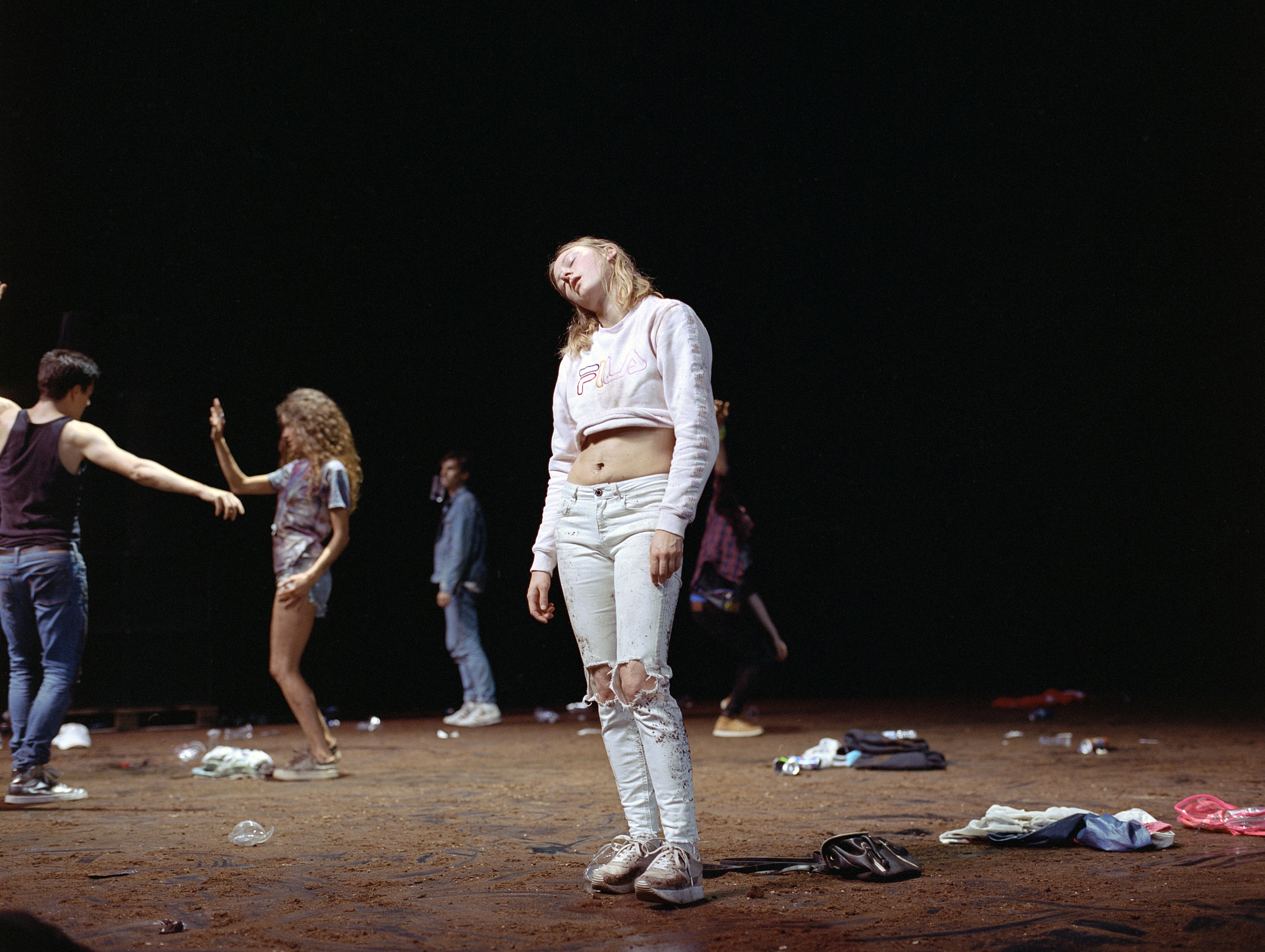
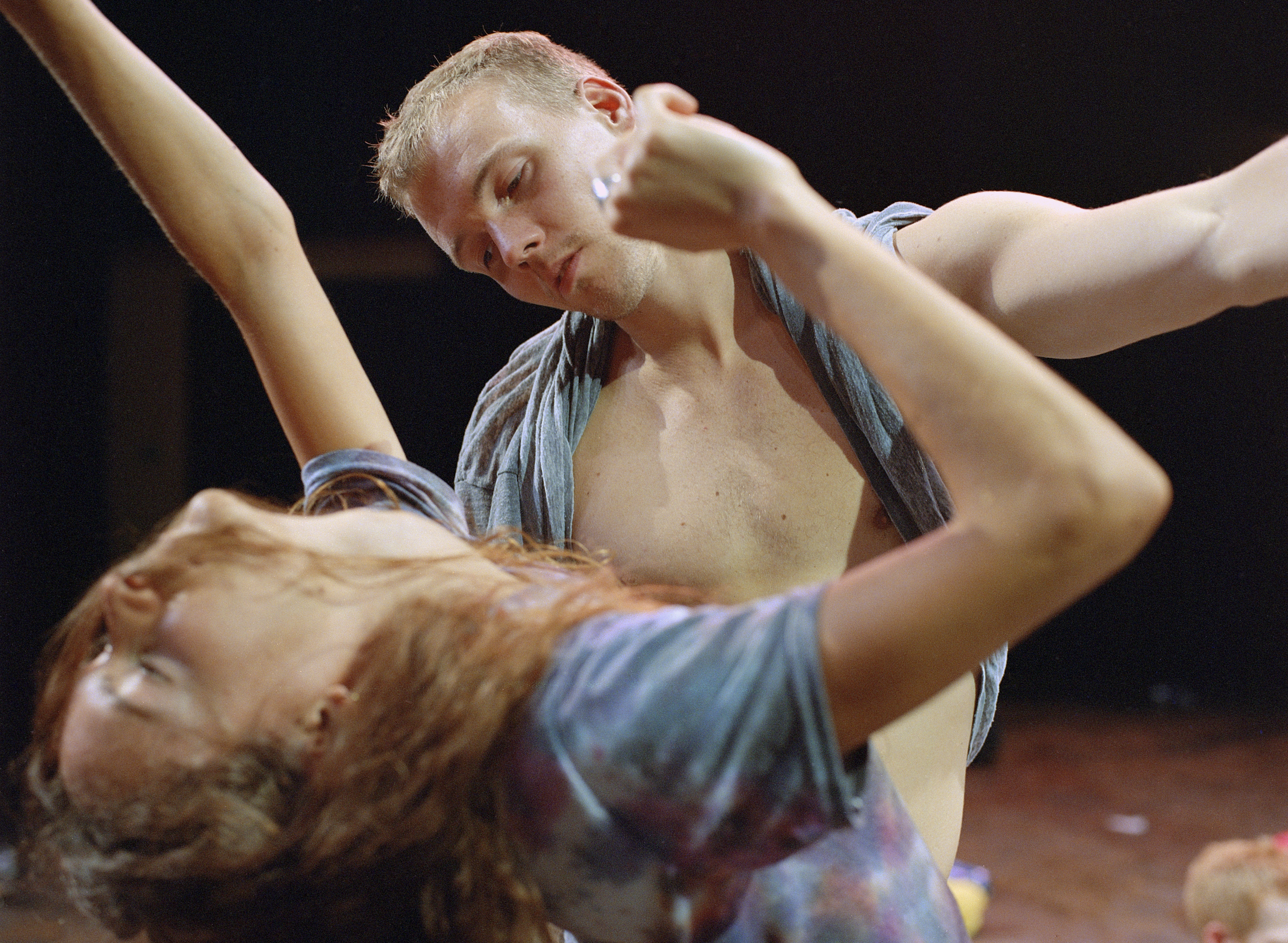
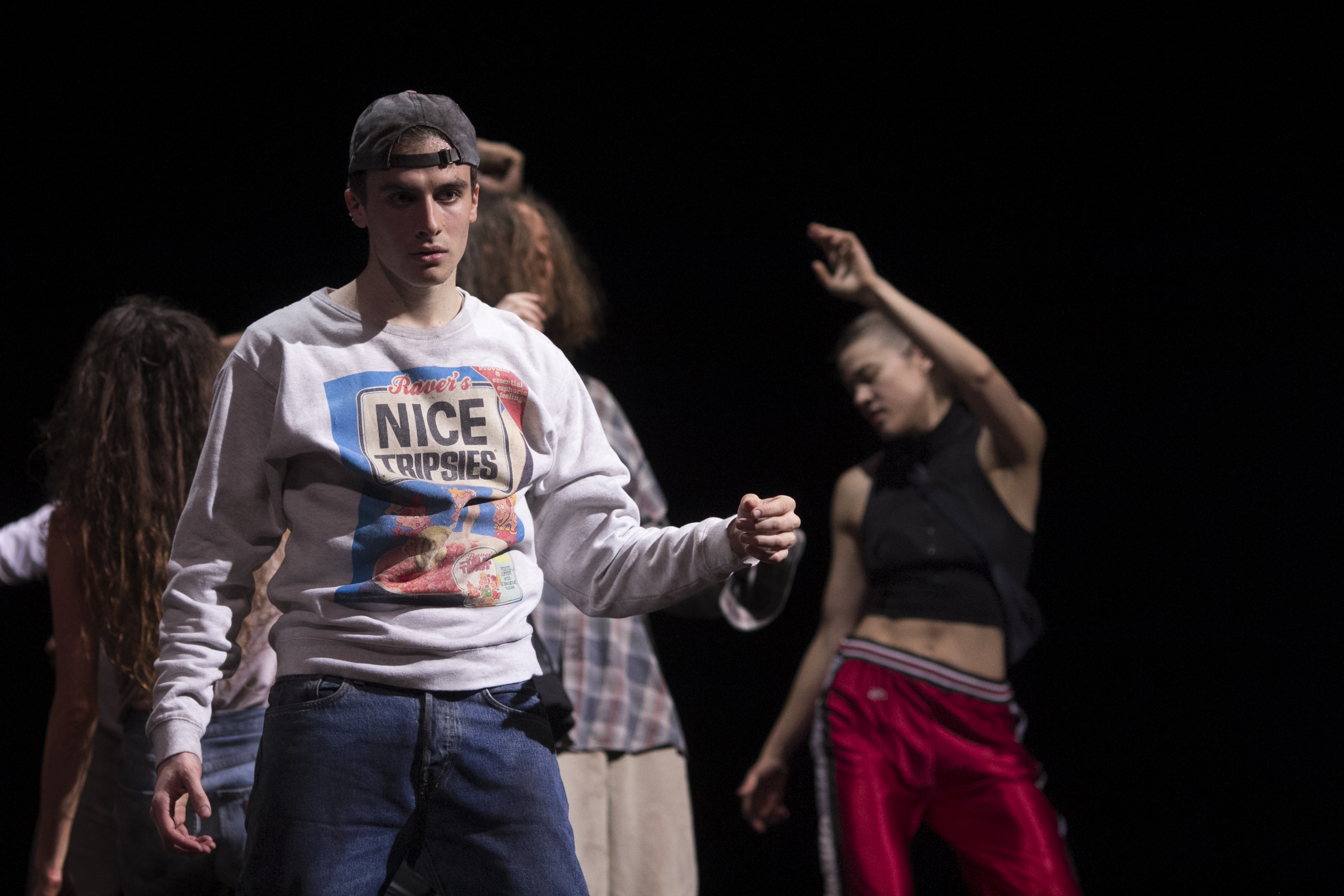
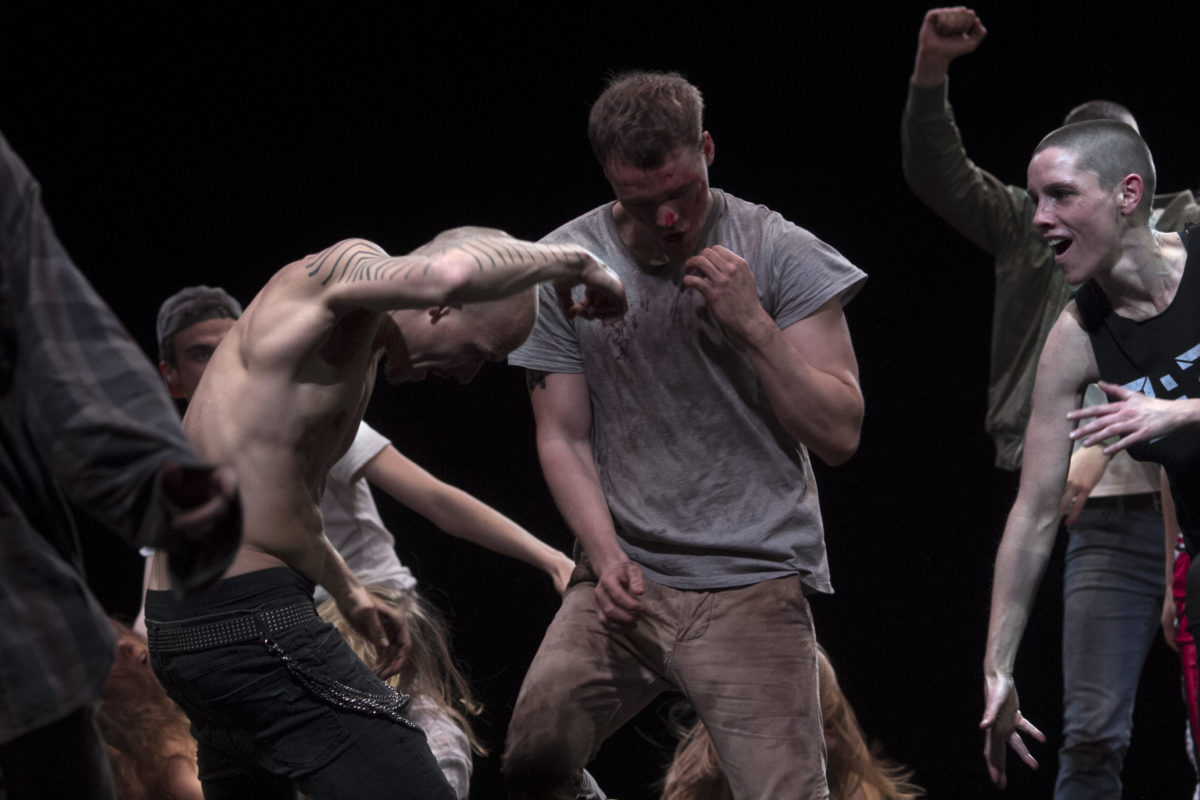
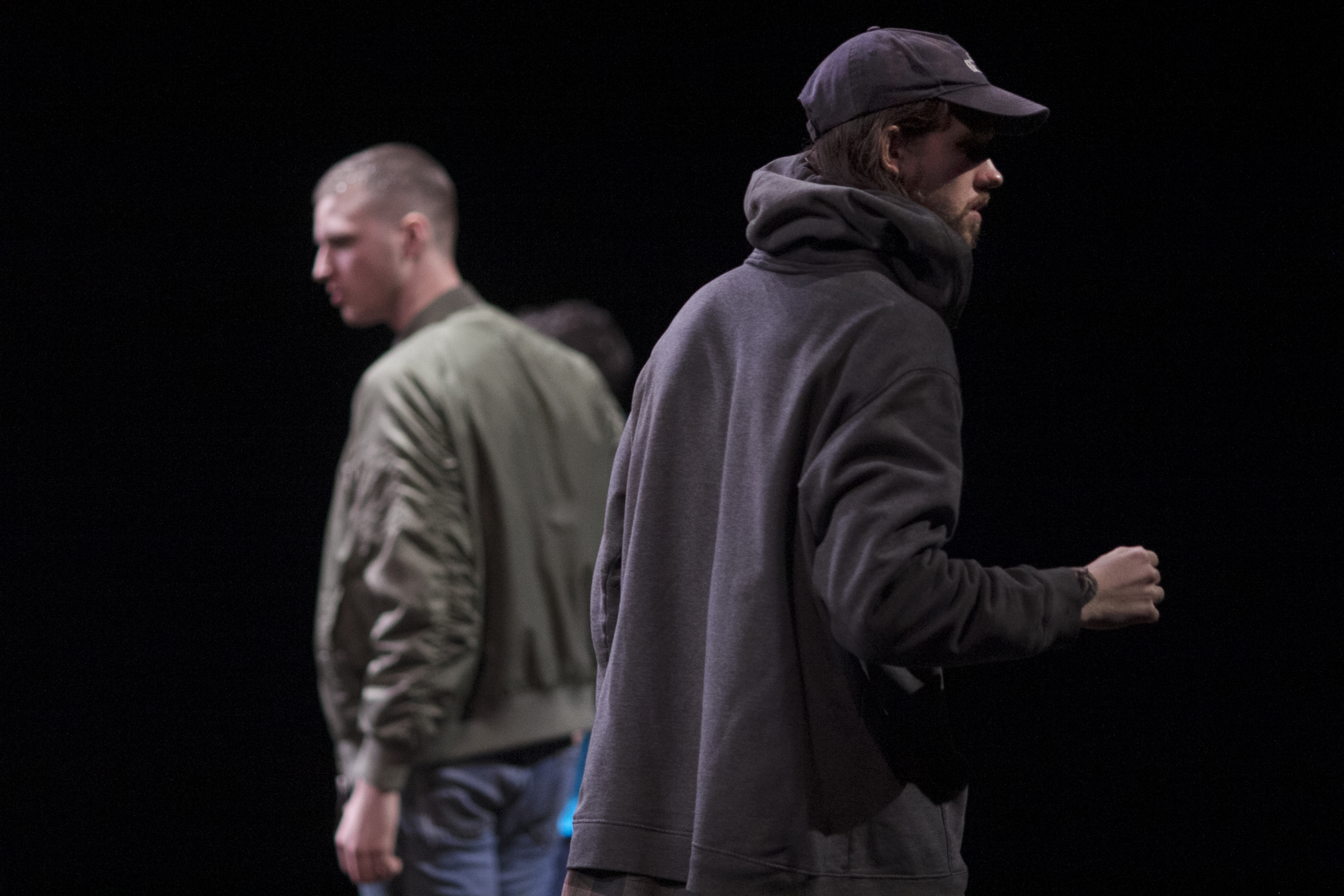
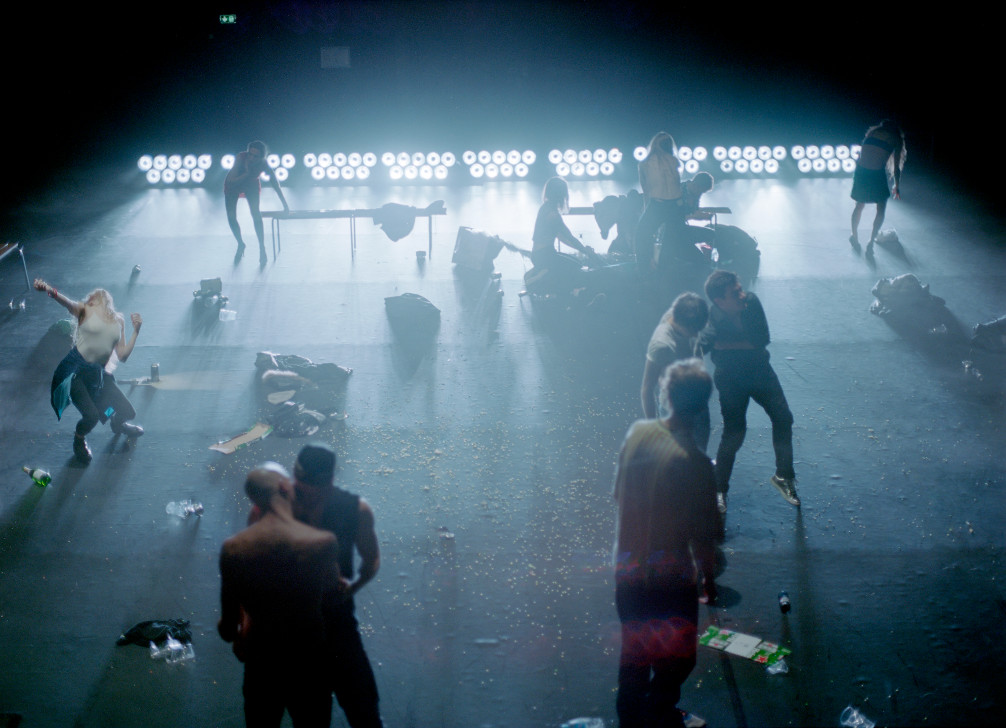
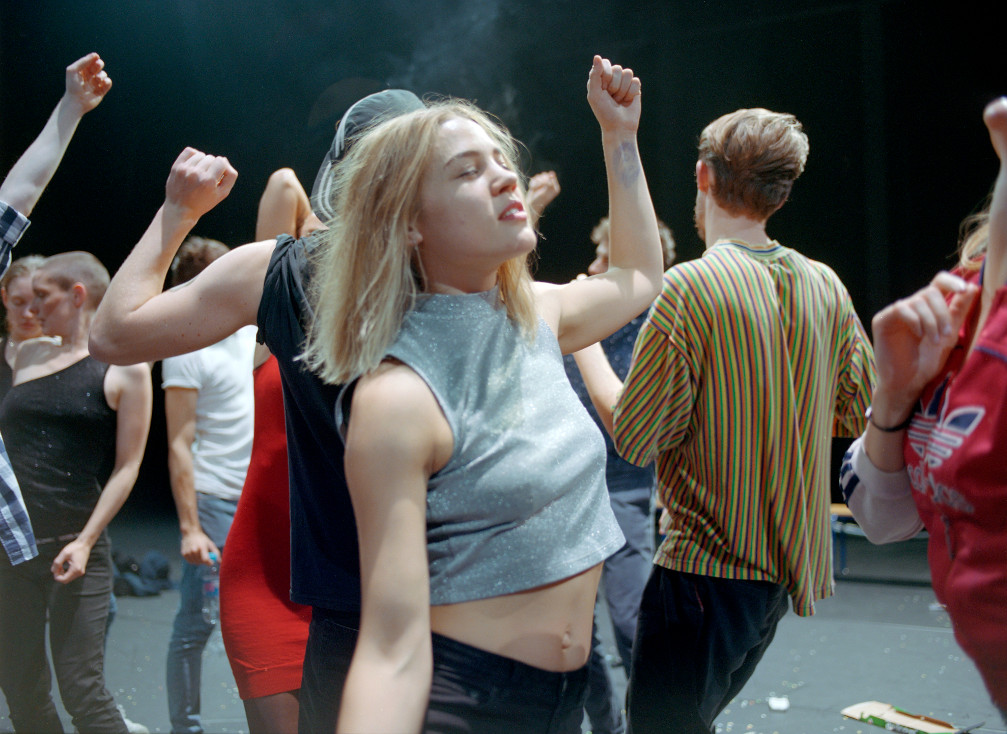
Crowd
Cast
To Kerstin
Conception, choreography and scenography Gisèle Vienne
Stage assistants Anja Röttgerkamp & Nuria Guiu Sagarra
Light Patrick Riou
Dramaturgy Gisèle Vienne & Dennis Cooper
Music selections from Underground Resistance, KTL, Vapour Space, DJ Rolando, Drexciya, The Martian, Choice, Jeff Mills, Peter Rehberg, Manuel Göttsching, Sun Electric & Global Communication
Edits and playlist selection Peter Rehberg
Sound diffusion supervisor Stephen O’Malley
Performers Lucas Bassereau, Philip Berlin, Morgane Bonis, Marine Chesnais, Sylvain Decloitre, Sophie Demeyer, Vincent Dupuy, Massimo Fusco, Nuria Guiu Sagarra, Rehin Hollant, Oskar Landström, Theo Livesey, Maya Masse, Nach, Katia Petrowick, Linn Ragnarsson, Jonathan Schatz & Henrietta Wallberg.
Created with Kerstin Daley-Baradel
Costumes Gisèle Vienne with the colaboration of Camille Queval & the performers
Set manager Antoine Hordé & Philippe Deliens
Sound engineer Adrien Michel
Light manager Iannis Japiot
Special thanks Louise Bentkowski, Dominique Brun, Zac Farley, Uta Gebert, Margret Sara Guðjónsdóttir, Isabelle Piechaczyk, Arco Renz, Jean-Paul Vienne, Dorothéa Vienne-Pollak, Etienne Hunsinger, Richard Pierre, Arnaud Lavisse, Adrien Biehler, Giovanna Rua & Erik Houllier.
Production and touring Alma Office Anne-Lise Gobin, Alix Sarrade, Camille Queval & Andrea Kerr
Administration Cloé Haas & Clémentine Papandrea
—
Music in order of appearance:
Underground Resistance The Illuminator (Underground Resistance, 1995)
KTL Lampshade (exclusive, 2017)
Vapour Space Gravitational Arch Of 10 (Plus 8, 1993)
DJ Rolando Vibrations mix (Underground Resistance, 2002)
– Underground Resistance Sweat Electric (Somewhere In Detroit, 1994)
– Underground Resistance Twista (Underground Resistance, 1993)
– Drexciya Wavejumper (Underground Resistance, 1995)
– The Martian The Intruder (Red Planet, 1992)
– Underground Resistance Code Red (Underground Resistance, 1993)
– Underground Resistance Lunar Rhythms (Somewhere In Detroit, 1995)
– Underground Resistance Hi-Tech Funk (Underground Resistance, 1997)
Choice Acid Eiffel (Fragile Records, 1992)
Jeff Mills Phase 4 (Tresor/Axis, 1992)
Peter Rehberg Furgen Matrix/Telegene (exclusive, 2017)
Manuel Göttsching E2-E4 (Inteam, 1984)
Sun Electric Sarotti (R&S Records, 1993)
Global Communication 14 31 (Ob-selon Mi-Nos) (Evolution, 1994)
Partners
Producer DACM
Coproducers Nanterre-Amandiers CDN // Le Maillon, Théâtre de Strasbourg – Scène européenne // Wiener Festwochen, Vienne // Le Manège Scène nationale de Reims // Théâtre National de Bretagne, Rennes // CDN Orléans/Loiret/Centre // BIT Teatergarasjen, Bergen // La Filature Scène nationale de Mulhouse
With the support of CCN2 – Centre Chorégraphique National de Grenoble and CND Centre national de la danse
Presentation
With Crowd, you are continuing your examination of our fantasmatic universe and the relationship between art and the sacred, something that has characterized your productions from the very beginning. However, isn’t this the first time that you are dealing with this subject in its collective dimension, and with such a large number of performers?
Up until The Pyre (2013) my pieces, regardless of the number of performers, have largely been about private space and superimposed intimacies through persons who are often rather isolated. Now, after The Ventriloquists Convention (2015), this is the second time that I’m depicting a group whose social activity and interactions play a central role. This group is certainly very different from that of the ventriloquists’ convention, since it’s a group of young people who have come together out of a desire for feelings of euphoria and out of a common interest in a musical genre, techno. The context chosen is that of a party. The staging of the group fits in nicely with the question of intimacy and its relation to the group, and the relationship between individual and collective emotions.
From the very beginning I’ve been interested in questions raised by sociologists, anthropologists, and philosophers on the relationship between the artistic and the religious and especially those thoughts and emotions which are improper, of their spaces of expression – archaic and contemporary, actual and potential. Whether it be eroticism, death, or violence, for example, these are issues that concern each of us and can disturb us, and might even jeopardize the community, depending on the way in which they are experienced.
With Crowd, there are often exhilarating aspects and outlets of expression of intensified emotions that develop through desire and the complex longing for love. The persons who go to this party, and thus form a community, are prepared to experience particularly intense emotions of any kind, and reach a state where their senses are already very much heightened. The group becomes excited by a piece where the structure and certain behaviors evoke various rituals. In the face of this emotional rollercoaster, the audience can likewise enter into a physical and emotional rapport with the piece.
What kind of place does music have in this work?
Peter Rehberg, who possesses an excellent knowledge of electronic music, proposed a number of tracks and on the basis of those I arrived at a selection for Crowd. He then did detailed work for the final mix.
I find it interesting that this selection in fact has a genuine historical relevance, since it’s made up of records that are important for the history of electronic dance music – works by musicians that are significant for the Detroit scene, among others, with Jeff Mills and other people from Underground Resistance, plus Manuel Göttsching, for example. The aim was to create a mix that covers an entire range of essential sounds that has been exciting for us over the last forty years.
Besides these tracks, which are used over the greater part of the production, there’s also an original piece composed by KTL (Stephen O’Malley and Peter Rehberg) and another by Peter Rehberg on his own.
And what is the role of Dennis Cooper’s text? You yourself have talked of a “subtext”…
The pieces – as is the world itself – are made up of different layers of texts, though not entirely. Language is not located solely in the realm of audibility. In Jerk (2008) the actor speaks throughout the entire play; with I Apologize (2004) very similar issues arise, although the same actor does not say a single word from the beginning to the very end. What Dennis Cooper and I have been passionate about, right from the start of our long collaboration, is the attempt with each project to reinvent new relationships to the text, to language, to speech, and to narration, and new ways of writing for the stage.
The “subtext” of Crowd is a text that is not audible but is partly intelligible. In Crowd, the fifteen dancers also constitute individual personae whose psychologies, imaginations, feelings, and histories are in each case very different. When you’re observing a party, there’s a huge number of “stories” that are unfolding right before your eyes; in Crowd there are histories and portraits of persons that Dennis has developed based on work done with the actors, which refines and influences the creation of the piece. This aspect of the piece brings to mind the process of mixing in music. It involves a mixing of narrations, as though you have fifteen different music tracks and you’re adjusting their respective volume levels, and thus a composition that allows the audience to have a key role in the way in which they will see and experience the piece.
This dissociation of the various planes – dream vs. reality, real vs. fantasy – that produces a feeling of time distortion is another characteristic of your work.
Crowd has a very rich formal potential. One of the central components of this type of piece occurs by way of the multiple stylization of the movements and their montage. This is not an imitation of the movements reworked, but a very intimate interpretation guided by the emotions and the intentions that can motivate the performers, their attentiveness, and their greater reception of what is unfolding around them. I likewise work with subdivisions – at certain points the dancers are going to all be in the same type of stylization, a common language, and at others they will be in a different type of gesture. This creates a very rich range of rhythmical and musical vibrations resulting in a slightly altered perception that is somewhat reminiscent of a hallucinatory or hypnotic feeling, and still producing meaning. In fact, this musical and choreographic work itself allows a narrative work to be created. This play of rhythms provokes a very strong feeling of time distortion. These distortions are highly dynamic, while simultaneously stretching time, making it possible to observe the persons and situations from close-up, and to dissect their actions in detail. Various temporalities are superimposed, through the same movements, but also in their relationship to the music and lighting, whose relationship to time varies almost constantly.
Interview by David Sanson for the Festival d’Automne à Paris 2017
Next performances
-
05 June 2025
-
01 June 2025
History
-
18, 19, 20, 21 December 2024La Villette With Chaillot - Théâtre National de la Danse
-
13, 14, 15, 16 November 2024Sophiensaele, a cooperation with Haus am Waldsee and Georg Kolbe Museum, Berlin
-
10 November 2024Festival euro-scene Leipzig, Schauspielhaus
-
01, 02, 03 November 2024National Theater and Concert Hall - Taipei, with the support of Dance Reflections by Van Cleef & Arpels
-
26, 27 October 2024Seoul Performing Art Festival (SPAF), Arko Main Theater, with the support of Dance Reflections by Van Cleef & Arpels.
-
03 July 2024Théâtre Pair/Impair Mimos, as part of Festival Mimos
-
30 March 2024CNDC–Angers (FR) Show co-presented with Le Quai CDN
-
09, 10 February 2024
-
06, 07 June 2023Opéra de Lille, Lille (FR) as part of festival Latitudes Contemporaines
-
05, 06 May 2023The Box, Freespace, Hong Kong (HK) with the support of Dance Reflections by Van Cleef & Arpels
-
22, 23 March 2023
-
17, 18, 19 March 2023
-
14 March 2023
-
10, 11 March 2023
-
26, 27 October 2022Los Angeles Dance Project, Los Angeles (USA) with the support of Dance Reflections by Van Cleef & Arpels
-
19, 20 October 2022Usine C, Montréal (CA) as part of the Festival Actoral - Montreal
-
13, 14, 15 October 2022Brooklyn Academy of Music, New York (USA) as part of Next Wave 2022
-
07, 08 October 2022O'Reilly Theatre, Dublin (IE) as part of Dublin Theatre Festival
-
17, 18 September 2022Teatro Argentina, Rome (IT) as part of Short Theatre Festival
-
11 May 2022
-
29, 30 April 2022
-
02 April 2022
-
19, 20 January 2022
-
15, 16, 17, 18 December 2021MC93 - Maison de la culture de Seine-Saint-Denis à Bobigny (FR) as part of the Festival d'Automne à Paris
-
02, 03 December 2021
-
11, 12, 13 November 2021
-
04, 05 February 2021Comédie de Genève (CH) [POSTPONED]
-
26, 27 January 2021Opéra de Lille (FR) [POSTPONED]
-
13, 14 January 2021
-
14 October 2020
-
24, 25 March 2020
-
05, 06, 07 March 2020
-
01 February 2020
-
31 January 2020
-
29 January 2020
-
15 December 2019
-
13 December 2019
-
06, 07 December 2019
-
20, 21 November 2019
-
16 October 2019
-
08, 09 October 2019
-
25, 26, 27, 28 September 2019
-
29, 30, 31 August 2019Finnish National Opera, Helsinki (FI) in the frame of Helsinki Festival
-
27 July 2019
-
01, 02 June 2019
-
23, 24 May 2019
-
02, 03 May 2019
-
26, 27 April 2019
-
23, 24 April 2019Lieu Unique, Nantes (FR) in the frame of the Festival Variations
-
04 April 2019
-
15, 16 March 2019Black Box teater, Oslo (NO) presented in collaboration between Oslo Internasjonal Teaterfestival and Dansens Hus Oslo
-
08, 09 March 2019
-
24 January 2019
-
08, 09 December 2018
-
17, 18 November 2018
-
09 November 2018
-
25, 26 October 2018
-
06, 07 October 2018
-
27, 28, 29 September 2018
-
25, 26 August 2018
-
10, 11, 12 August 2018
-
30 July 2018
-
06, 07 July 2018
-
27, 28 June 2018
-
13, 14, 15 June 2018
-
01, 02 June 2018
-
31 May 2018
-
29 May 2018
-
27, 28 February 2018
-
06, 07, 08, 09 February 2018
-
26, 27 January 2018
-
07, 08, 09, 10, 12, 13, 14, 15, 16 December 2017
-
25 November 2017
-
15 November 2017
-
08, 09, 10 November 2017
